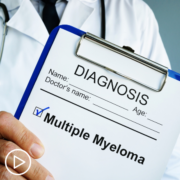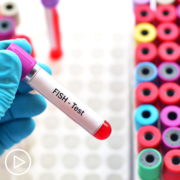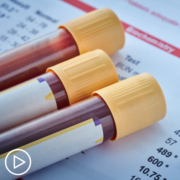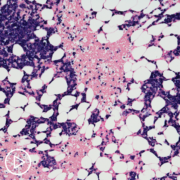Myeloma Maintenance Therapy | What Patients Need to Know from Patient Empowerment Network on Vimeo.
What should myeloma patients know about maintenance therapy? Expert Dr. Benjamin Derman discusses the role of maintenance therapy, data presented at the 2022 American Society of Hematology (ASH) meeting, and the role of minimal residual disease (MRD) testing in myeloma care.
Dr. Benjamin Derman is a hematologist and oncologist specializing in multiple myeloma at the University of Chicago Medicine Comprehensive Cancer Center. Learn more about Dr. Derman.
See More from Engaging in Myeloma Treatment Decisions
Related Resources:
Transcript:
Katherine:
When a patient goes into remission, they’re often placed on a maintenance therapy. What’s the role of maintenance therapy in myeloma care?
Dr. Derman:
Yeah. So, maintenance, just to specify, is typically something that we call a long duration of usually, less intensive therapy after a more intensive schedule of therapy. So, the most common area that we talk about maintenance is after, let’s say, an autologous stem cell transplant, which came after induction therapy that I mentioned.
But for patients even who don’t go to a stem cell transplant, they can also go on maintenance therapy. So, when we think about the frontline setting, which in this case would be induction transplant maintenance, the most commonly used drug is a single agent lenalidomide (Revlimid). And that’s been shown to have survival benefits not just in keeping the disease away, but also helping patients live longer. So, maintenance therapy does seem to carry some real importance. One of the things though that we don’t know, is really how long patients need to be on maintenance therapy.
So, we can all accept I think in the myeloma field, if there’s one thing we can agree on, is that maintenance is important. But the question is, what makes up that maintenance therapy? And then how long? Those are questions we don’t really have the best answers to. And actually, one of the areas that I do quite a bit of research in is about this, how long do patients need to be on therapy?
So, we recently published some – we presented at ASH this year in 2022, some recent data, at least a preliminary data on patients who had really deep responses, and who we stopped their maintenance therapy after at least one year – but the average was about three-and-a-half years on maintenance therapy – to see if the disease would actually be at risk of coming back.
And so, what we’re finding is that even in the first year, about 85 percent of patients did not have their disease come back after stopping therapy. So, maintenance therapy is certainly important, but I think we still have to figure out how long patients need to be on that therapy.
Katherine:
Right. And I can imagine that each person, each patient is different, and some – the maintenance therapy would work really well for them for a long period of time. For others, not necessarily.
Dr. Derman:
Yeah. I mean, a lot of it comes down to the risk there of the patient’s myeloma. And what I mean by that is – so, somebody has explained to me previously, and I really like the analogy that myelomas are kind of like people. They have different personalities, and they give first impressions. And sometimes your first impression of a myeloma may end up being wrong. You thought it was going to be really hard to treat and you found out that it actually responded pretty nicely to therapy. And other times, it’s the other way around.
But for the ones that give us a bad first impression, we’re going to be treating those patients typically more aggressively. At least that’s my personal approach. And I take that all the way through from induction, to transplant, even into maintenance therapy where I mentioned already, most people will prescribe a single drug as maintenance therapy. But for those patients, I’m typically going to be prescribing more than that. Or I will continue more aggressive therapy for longer. So, that’s where you have to sort of adapt your therapy in some cases to the patient and their disease characteristics.
Katherine:
Related to maintenance therapy, we received this question before the program. How do doctors feel about maintenance breaks if you are MRD-negative? Or in a very good response?
Dr. Derman:
So, I want to be very careful about how I respond to this. Because what I’m going to say is, there’s currently no data to tell us that patients should stop. I mean, in part that’s, you should stop therapy. In part that’s what I’m hoping that we can answer with our study. There’s another large cooperative group study trying to answer this as well, about the duration piece and whether people can stop.
So, a very good partial response signifies at least a 90 percent reduction in the tumor, in the myeloma, but not 100 percent.
And there’s also a complete response, which means there’s no detectable disease by conventional methods in the bone marrow or in the blood, but that there can still be microscopic or low levels of cancer cells which we call minimal residual or measurable residual disease. Also called MRD.
So, MRD negativity is a not so nascent field now, where we are trying to quantify small amounts of cancer cells that may still be present. And the theory is that the presence of residual disease at a small measurable level is what’s ultimately responsible for myeloma relapsing.
We used to think like, “Oh, a patient is in a complete response. That’s amazing. Let’s clink our champagne glasses. Let’s celebrate.” And there’s still cause for celebration for that. That is a great achievement. But we know that that doesn’t mean we can rest on our laurels. If there is MRD-positive disease, then the disease, it can likely come back. And that’s where suppression of the disease with something like maintenance therapy with lenalidomide is probably helping a lot.
Katherine:
Yeah.
Dr. Derman:
But let’s say we have people who don’t have detectable disease, the question is, can they stop? And like I mentioned, we’re trying to answer that question. I would say right now, there’s no recommendation for that. I can’t say in good faith that you should be doing that, unless it’s as part of a clinical trial, which is what we’re hoping to answer.




























